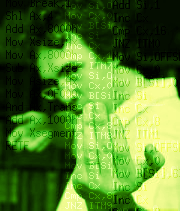- [done] once moving on a blador, I cannot stop: I slide. That's because "onpath" so far short-circuits "stopper" who was in charge of both bringing Bilou (with some inertia) to stop and check whether he'll fall. These two will have to be split for "onpath" to work properly.
- [done] I am not detached when I leave the blador, making me slide even when I walking *past* the blador.
- [done] if bladors are stacked onto each other, make the upper one fall when the lower recovers.
- [done] same if the lower got picked up.
- [check] I may still end up not on the platform, but still forbidden to fall. Repelled and not attached am I ?
- [todo] Why is there a slight bounce when I'm done picking a blador ?
- [todo] horizontal speed killed when landing on a blador. But at least we can nicely move *out* of a blador.
- [done] Why am I able to "restore" a blador when I pick up the one he's standing on with random chance ?
- [todo] whatever went wrong with Bilou vs Inkjets ... fix it.
Saturday, May 17, 2014
Walking on Bladors
Wednesday, May 07, 2014
Game scripts todo list
- [now] One can land on a stunned blador, but can't walk on him.
- [todo] 1/3-2/3 for the hero position on screen gives more room to anticipate, which is great when running, but a center position is nice when you have monsters all around you. Using the (R) shoulder to "look ahead" (direction-dependent) should be investigated.
- [todo] the "chalk" gob is crying for being polished, both art and behaviour. Having the chalk-gob being the only thing able to break the chalk-tiles would likely be the best approach to avoid curious behaviour.
- [done] when thrown in pencils, dumblador should stop slightly above "the ground".
- [done] update maps make pencils spikes reacting to ennemies too.
- [check] granted, we cannot attach or repell them, but can we allow line-up operations against BLOCKs ?
Tags: attach, dumblador, school zone, scrolling, todo
Thursday, May 01, 2014
Critical Link #2: Sword & Overworld
Quand on crée un jeu basé sur l'exploration libre, les va-et-viens entre différents lieux sont plutôt inévitable: personne n'aura le réflexe de se dire "ah! je sais: je vais amener le balais à Mamie Youpie" s'il n'a pas rencontrer Mamie Youpie auparavant. Il faudra donc y retourner. Ça ne fait pas de tort qu'il soit possible à quelqu'un qui connaît bien le jeu d'optimiser ses déplacements, mais cela veut surtout dire qu'il est primordial que le terrain qui est re-parcouru soit suffisamment riche pour que le joueur n'ait pas la sensation d'être obligé de répéter les même actions encore et encore.
 Sword fights involve some navigation with the DPAD and use of the ATTACK button at the right time. Compared to the original LoZ (Legend of Zelda, NES) Z:LA's sword slash covers almost three tiles, making many monsters vulnerable to a dominant strategy: approach them one tile below or one tile sideway to slash them without danger. But to get that succesful, you'll have to plan your navigation and use the level elements to trick monsters and trap them. Z:LA's world map features many places with enough alternate paths to make those trap possible, but optional and preferably not too obvious.
Sword fights involve some navigation with the DPAD and use of the ATTACK button at the right time. Compared to the original LoZ (Legend of Zelda, NES) Z:LA's sword slash covers almost three tiles, making many monsters vulnerable to a dominant strategy: approach them one tile below or one tile sideway to slash them without danger. But to get that succesful, you'll have to plan your navigation and use the level elements to trick monsters and trap them. Z:LA's world map features many places with enough alternate paths to make those trap possible, but optional and preferably not too obvious. On est encore dans le domaine du "gameplay émergent", je trouve, quand les concepteurs de Link's Awakening nous construisent une plaine pointillée de rocs isolés et de trous à contourner. On retrouve moins ce côté dans Z:LTTP (Link to the Past), ce qui signifie aussi moins de liberté, moins d'options pour trouver le moyen de passer le long de chez Mamie-Magie en contournant les créatures électrifiées.
On est encore dans le domaine du "gameplay émergent", je trouve, quand les concepteurs de Link's Awakening nous construisent une plaine pointillée de rocs isolés et de trous à contourner. On retrouve moins ce côté dans Z:LTTP (Link to the Past), ce qui signifie aussi moins de liberté, moins d'options pour trouver le moyen de passer le long de chez Mamie-Magie en contournant les créatures électrifiées.Pour comprendre comment celà peut avoir tant d'importance, il faut regarder en détails les nuances du gameplay. Ici, la plupart des adversaires passent dans un mode plus aggressif lorsqu'ils se retrouvent alignés avec le joueur. Parce que la plupart des monstres demanderont deux coups d'épée mais peuvent être éliminés en un coup tournoyant, il devient stratégiquement intéressant de s'exposer pour pouvoir placer ce coup. L'angle sous lequel se fait l'approche peut aussi désavantager le joueur en le plaçant dans une passe d'arme sans fin.


Surprisingly, this does not work that well in Z:LTTP. First because you face many ennemies that are merely hurt by the SPIN attack. They're not really repelled either and the risk of being too close to them is real. Moreover, other guards nearby are alerted by your SPIN attack, so you'll end up with a tighter fight. Last, keeping your blade charged significantly slow you down while moving. The price to pay for using a SPIN attack becomes much higher, the time window you have for an optimal SPIN is squeezed. It is no longer a mere matter of strategy and anticipation: it requires timing skills, careful observation of the surrounding and knowledge of the hitpoints each variant of the soldiers have to avoid mistakes.
 Avec pas mal d'ennemis qui sont à peine blessés par l'attaque tournoyante et qui restent à nous courir après, ce genre de stratégie n'est pas vraiment gagnante dans Z:LTTP. Le boomerang ou autre technique similaire pour assomer les ennemis et les vaincres sans péril pendant qu'ils sont immobilisés se révèle bien plus efficace et généralement préférable pour son niveau de vie quand ils sont en groupe. Avec la façon dont les bottes (de pégase ou à l'épée) attirent l'attention de ces gardes, on aurait généralement bien tort d'essayer de faire de l'épate... à moins justement qu'il y ait l'un ou l'autre buisson pour les canaliser, préparer son attaque et couper d'un coup garde et buisson.
Avec pas mal d'ennemis qui sont à peine blessés par l'attaque tournoyante et qui restent à nous courir après, ce genre de stratégie n'est pas vraiment gagnante dans Z:LTTP. Le boomerang ou autre technique similaire pour assomer les ennemis et les vaincres sans péril pendant qu'ils sont immobilisés se révèle bien plus efficace et généralement préférable pour son niveau de vie quand ils sont en groupe. Avec la façon dont les bottes (de pégase ou à l'épée) attirent l'attention de ces gardes, on aurait généralement bien tort d'essayer de faire de l'épate... à moins justement qu'il y ait l'un ou l'autre buisson pour les canaliser, préparer son attaque et couper d'un coup garde et buisson.Et les îles peu convaincantes de Phantom Hourglass, dans tout ça ? Avec des buissons à travers lesquels le joueur passe sans les trancher, exit les embuscades. Les ennemis qui sortent du sol avec une animation telle qu'il est possible de les semer avant même qu'ils n'entre en action, mais qu'il n'est pas possible de choisir une trajectoire sûre ou osée selon son humeur ont rendu les parcours sur la terre ferme linéaires. Et comme un simple clic fait bondir Link vers sa cible pour lui asséner un coup direct, quelque soit leur position respectives, le dernier élément qui rendait le parcours du territoire intéressant est lui aussi enterré d'un coup de stylet. Les encerclements par les ennemis y sont donc légion, malheureusement manquant d'aggressivité pour être réellement inquiétants.
Tags: designclass, gameplay, level design, mechanics, monster design, rpg





 Vote for your favourite post
Vote for your favourite post

